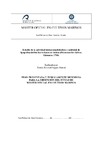Identificador persistente para citar o vincular este elemento:
https://accedacris.ulpgc.es/handle/10553/74479
| Campo DC | Valor | idioma |
|---|---|---|
| dc.contributor.advisor | Acosta Arbelo, Félix Antonio | es |
| dc.contributor.advisor | Bravo García, Jimena | es |
| dc.contributor.author | Segura Bernal, Tomás Kristuel | es |
| dc.date.accessioned | 2020-09-18T10:24:21Z | - |
| dc.date.available | 2020-09-18T10:24:21Z | - |
| dc.date.issued | 2019 | en_US |
| dc.identifier.uri | https://accedacris.ulpgc.es/handle/10553/74479 | - |
| dc.description.abstract | La Encefalopatía y Retinopatía Vírica es causante de mortalidades masivas de peces marinos, hasta un 100% cuando se encuentran en su fase larvaria y en juveniles. Para controlar las enfermedades están aplicándose cada vez más el uso de vacunas y de inmunoestimulantes. La vacunación es el método más apropiado para el control de enfermedades causadas por patógenos desde el punto de vista económico, ético y medioambiental. Son preparaciones biológicas que contienen el antígeno o antígenos apropiados que estimulan el sistema inmunológico. Después de la vacunación, el contacto con el patógeno debería provocar una respuesta fuerte en el pez que limitará la reproducción del patógeno y evitará la aparición de la enfermedad. La respuesta inmune innata representa la respuesta temprana e inespecífica a las infecciones, en ellas encontramos diferentes respuestas como la respuesta inflamatoria (IL- -6, etc.), antinflamatoria (IL-10, etc.), apoptótica (Caspasa 3, etc) y antiviral (IFN, gen Mx). Se puede estudiar la activación del IFN a través de la expresión del gen Mx. En nuestro estudio realizamos la inmunoestimulación en lubina para analizar la progresión de la respuesta inflamatoria, antinflamatoria, apoptótica y antiviral en peces inmunoestimulados y no estimulados. Así como la expresión de Mx y la capacidad de controlar la infección por Nodavirus de forma experimental. Los resultados mostraron que los grupos estimulados con LPS tuvieron una respuesta inflamatoria y apoptótica temprana, débil e inestable. No existió una respuesta antinflamatoria y la respuesta antiviral fue estable y continuada en el tiempo. Los grupos estimulados con LPS demostraron una respuesta que se incrementaba en el tiempo obteniendo su máxima expresión al sexto día. Cuando estos grupos inmunoestimulados fueron infectados, presentaron una respuesta Mx más rápida y de mayor intensidad junto con una menor replicación del virus en el sistema nervioso que los peces no estimulados. | en_US |
| dc.description.abstract | Encephalopathy and Viral Retinopathy is responsible for massive mortalities of marine fish, up to 100% when they are in their larval phase and in juveniles. To control diseases, the use of vaccines and immunostimulants is increasingly being applied. Vaccination is the most appropriate method for the control of diseases caused by pathogens from an economic, ethical and environmental point of view. They are biological preparations that contain the appropriate antigen or antigens that stimulate the immune system. After vaccination, contact with the pathogen should provoke a strong response in the fish that will limit the reproduction of the pathogen and prevent the appearance of the disease. The innate immune response represents the early and non-specific response to infections, in them we find different responses such as the inflammatory response (IL- -6, etc.), anti-inflammatory (IL-10, etc.), apoptotic (Caspase 3, etc.) and antiviral (IFN, Mx gene). The activation of IFN can be studied through the expression of the Mx gene. In our study, we performed immunostimulation in seabass to analyse the progression of the inflammatory, antinflammatory, apoptotic and antiviral response in immunostimulated and unstimulated fish. As well as the expression of Mx and the ability to control the infection by Nodavirus experimentally. The results showed that the groups stimulated with LPS had an early, weak and unstable inflammatory and apoptotic response. There was no anti-inflammatory response and the antiviral response was stable and continued over time. The groups stimulated with LPS showed a response that increased over time obtaining its maximum expression on the sixth day. When these immunostimulated groups were infected, they presented a faster and more intense Mx response together with a lesser replication of the virus in the nervous system than unstimulated fish. | en_US |
| dc.language | eng | en_US |
| dc.subject | 310502 Piscicultura | en_US |
| dc.subject.other | Fish deseases | es |
| dc.subject.other | Immunostimulation | es |
| dc.subject.other | Seabass | es |
| dc.title | Estudio de la actividad inmunomoduladora y antiviral de lipopolisacáridos bacterianos en lubina ("Dicentrarchus labrax", Linnaeus 1758) | es |
| dc.type | info:eu-repo/semantics/masterThesis | en_US |
| dc.type | MasterThesis | en_US |
| dc.contributor.departamento | Departamento de Patología Animal, Producción Animal, Bromatología Y Tecnología De Los Alimentos | es |
| dc.contributor.facultad | Facultad de Ciencias del Mar | en_US |
| dc.investigacion | Ciencias | en_US |
| dc.type2 | Trabajo final de máster | en_US |
| dc.description.notas | Máster oficial de Cultivos Marinos 2018-2019. Diploma de Master of Science en Acuicultura otorgado por el Centro Internacional de Altos Estudios Agronómicos Mediterráneos (CIHEAM) | en_US |
| dc.utils.revision | Sí | en_US |
| dc.identifier.matricula | TFT-46489 | es |
| dc.identifier.ulpgc | Sí | es |
| dc.contributor.titulacion | Máster Universitario en Cultivos Marinos | es |
| item.grantfulltext | restricted | - |
| item.fulltext | Con texto completo | - |
| crisitem.advisor.dept | GIR Grupo de Investigación en Acuicultura | - |
| crisitem.advisor.dept | IU de Investigación en Acuicultura Sostenible y Ec | - |
| crisitem.advisor.dept | Departamento de Patología Animal, Producción Animal, Bromatología y Tecnología de Los Alimentos | - |
| crisitem.advisor.dept | GIR Grupo de Investigación en Acuicultura | - |
| crisitem.advisor.dept | IU de Investigación en Acuicultura Sostenible y Ec | - |
| Colección: | Trabajo final de máster Restringido ULPGC | |
Visitas
191
actualizado el 10-ago-2024
Descargas
55
actualizado el 10-ago-2024
Google ScholarTM
Verifica
Comparte
Exporta metadatos
Los elementos en ULPGC accedaCRIS están protegidos por derechos de autor con todos los derechos reservados, a menos que se indique lo contrario.
